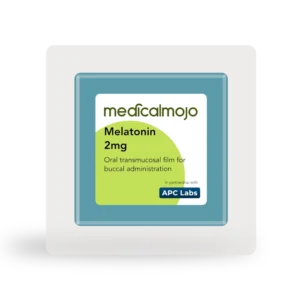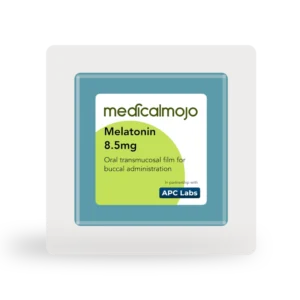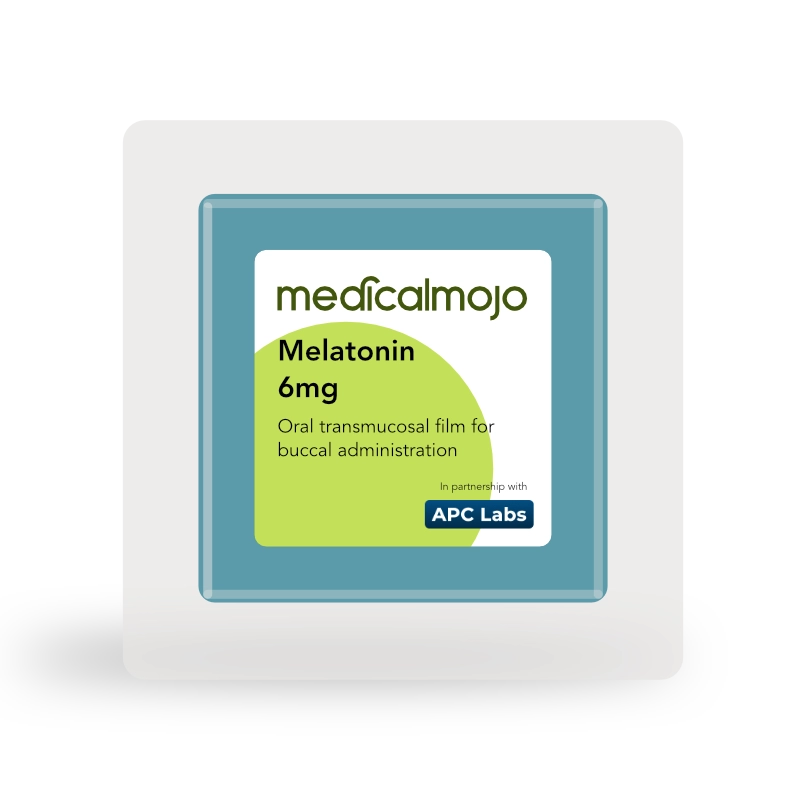Melatonin is a hormone produced by the pineal gland in the brain to help us fall asleep. Before we discuss Melatonin, let’s look at how we reach the land of nod.
Table of contents
-
 Melatonin 5mg soluble oral patchPrice range: £35.99 through £99.99
Melatonin 5mg soluble oral patchPrice range: £35.99 through £99.99 -
 Melatonin 2mg soluble oral patchPrice range: £35.99 through £99.99
Melatonin 2mg soluble oral patchPrice range: £35.99 through £99.99 -
 Melatonin 8.5mg soluble oral patchPrice range: £35.99 through £99.99
Melatonin 8.5mg soluble oral patchPrice range: £35.99 through £99.99
How do we fall asleep
Reaching that blissful land of restful sleep requires two separate processes in the brain coming together. The first is the basic rhythm of the brain over its 24-hour (circadian) cycle, which is part-controlled by the hormone melatonin. We take this circadian rhythm for granted but experience its wrath when changing our time zones; it then rewards us with the experience of jet lag. This rhythm makes it hard to go to sleep when we go east and hard to wake up when we go west. Please read our blog about jet lag and how to minimize its side effects.
The other sleep driver is the “pressure” to sleep that increases the longer we are awake. You know the feeling; you have a deadline, and as usual, you have left it to the last minute, so you need to burn the midnight oil. At these times, this other sleep driver kicks in, the pressure to sleep increases, and it’s hard to resist without copious cups of coffee. This pressure to sleep is driven by the accumulation of metabolic products in the brain over the day. Please read our blog to learn more about how caffeine blocks the effects of adenosine.
When both processes are synchronised, sleep comes relatively quickly, but if they are out of phase, e.g. with jet lag or shift work, it is much harder to fall asleep.
For the rest of this blog, we will focus on the first sleep driver since this is influenced by the hormone melatonin.
What is a Zeitgeber?
Picture the circadian rhythm as an internal clock, and just like any clock, it needs to be adjusted or reset on occasion, but how does the brain manage to do this? We are now aware of the influence of environmental cues or influences that gently nudge our circadian rhythms forward or back.
These are termed Zeitgebers – “givers of time” in German. Left to its own devices, the human circadian rhythm is set to 24.2 hours, and without these Zeitgebers, our internal clocks would quickly start gaining or losing time, and they would no longer be the envy of Swiss watchmakers.
Our internal clock is sensitive to temperature, physical activity and eating. Still, by far, the most potent Zeitgeber is light, particularly at the blue end of the spectrum, like sunlight… and this is where melatonin makes its grand entrance.
Melatonin and the Circadian Rhythm.
The Pineal gland
Much of the influence of the intrinsic clock or circadian rhythm on the brain is mediated via a hormone called melatonin. This hormone is secreted by the pineal gland, a tiny pine-cone-shaped structure deep within the brain’s centre.
Rene Descartes, the famous philosopher who said, “I think therefore I am”, proposed that this tiny area of the brain was the seat of the soul. Although we now know that it does not provide habitation for such an esteemed guest, it nonetheless plays a crucial role in allowing us to get a restful night’s sleep.
The pineal gland’s primary function is to transform the light and dark information from the environment to allow it to release melatonin. Working together with a structure in the brain called the suprachiasmatic nucleus (SCN), it produces and spews out melatonin in a cyclical fashion.
Before we move on, let’s take a quick detour to learn more about the suprachiasmatic nucleus.
What is the Suprachiasmatic Nucleus?
The suprachiasmatic nucleus (SCN) is a small region in the brain’s hypothalamus. It is the primary circadian pacemaker, orchestrating the body’s internal clock and regulating the sleep-wake cycle (circadian rhythm).
The SCN receives input from the eye’s retina, allowing it to detect changes in light and dark cycles. This information then synchronises the body’s internal clock with the external environment. The SCN sends signals to various brain regions and the pineal gland, influencing the secretion of hormones such as melatonin to promote wakefulness or sleep at appropriate times.
Overall, the suprachiasmatic nucleus plays a critical role in regulating the body’s internal clock and coordinating daily rhythms of activity and rest.
Ok, so now we understand what the SCN is and how it relates to the circadian rhythm, let’s get back to melatonin.
Normal melatonin release
For people with normal sleep/wake cycles, melatonin levels rise in the early evening, stay elevated at night and then drop back down a couple of hours before waking. Melatonin is the chemical signal that nudges the brain to sleep.
Melatonin receptors are not just found in the brain but are also distributed in other tissues throughout the body, such as the kidneys, gut, heart and lungs, skin, and reproductive organs. Please read our blog on melatonin and testosterone to see how it relates to this vital male hormone.
Natural light and melatonin
The light around you right now allows you to read these words and has another hidden effect on your brain. This light entering your eyes causes your retinas to produce tiny electrical signals that stimulate your SCN and pineal gland.
When these brain structures receive this electrical tickle, they stop producing the sleep-inducing hormone melatonin, so you feel alert and awake. However, when the day fades to night, bathing you in darkness, this stimulation from the retina ceases to stimulate these bits of the brain, and the subsequent release of melatonin makes you feel drowsy and tired.
The Dracula hormone
For this reason, neuroscientists often refer to melatonin as the “Dracula Hormone” because it only emerges in the dark. As well as being the chemical cue that the pineal gland churns out to signal the chiming of the circadian clock, melatonin also directly influences that clock. Melatonin feeds back on the SCN and so is itself a Zeitgeber.
So, we can now tweak and adjust our internal clocks by manipulating either melatonin or light levels. Both techniques are easy; we can take a melatonin tablet, or better yet, a transmucosal film of melatonin placed in the mouth or expose people to very bright light in the form of a lightbox. These lightboxes stimulate natural sunlight and are rich in blue light, which seems to have the most significant effect on retinal ganglion cells.
Disruption of the Circadian Rhythm
This cyclical rise and fall of melatonin allow us to calculate the length of someone’s circadian rhythm. All we have to do is monitor melatonin levels’ rise and fall in the blood.
This seems good in theory, but it’s not relatively easy in practice since exposure to light can disrupt melatonin levels. Not only does this make measuring circadian rhythms hard, but we are now facing a pandemic of circadian rhythm disruption caused by our favourite pastime of scrolling on social media.
Artificial blue light and melatonin
The widespread use of laptops and mobile phones that emit blue light confuses the brain, which is used to take environmental cues. When it is night, it is dark, which then starts the melatonin production, but life in the 21st century with its artificial blue light has thrown the brain a curve ball; it now doesn’t know precisely when to start its melatonin production. We can mitigate the effect of blue light on melatonin production by stopping scrolling social media on our phones before bed, using the blue filter, or, even more extreme, using special blue filter glasses.
Having trouble sleeping?
Try clinically proven sleep disorder treatments for a better night’s sleep.
Learn more
When to give Melatonin?
So, to help bring the circadian rhythm back to normal, for instance, when recovering from jet lag or shift work, the timing of taking melatonin in relation to the underlying circadian clock is crucial. Depending on when on the circadian cycle melatonin is delivered, it can have very opposite effects. Taking melatonin in the early evening will cause you to fall asleep earlier. However, taking the melatonin in the morning will push your bedtime back. In practice, melatonin is rarely taken in the morning as it may make you drowsy. However, there is some evidence that even small doses can cause a shift in the circadian clock without causing significant drowsiness.
Is Melatonin legal in the UK?
In the UK, melatonin is a prescription-only medicine (POM). This designation means it is legal for use when prescribed by a doctor or healthcare professional. Unlike in the US, where melatonin is available in supplements from health food stores, melatonin cannot be sold without a prescription in the UK. Therefore, selling melatonin in the form of supplements, such as melatonin gummies, without a prescription is illegal. It is important to note that any sale of melatonin without a doctor’s prescription is considered unlawful in the UK.
What is Melatonin prescribed for?
In the UK, melatonin can be prescribed to address jet lag, a condition characterised by fatigue, sleep disruptions, daytime fatigue, and cognitive impairment that commonly occurs after long flights crossing multiple time zones.
Additionally, melatonin may be prescribed for short-term usage in adults aged 55 and above who are experiencing insomnia and sleep disturbances. In some cases, specialists may also prescribe melatonin to treat sleep disorders in children.
Can you buy Melatonin in the UK?
Melatonin supplements, including melatonin gummies, are not legally available for sale in the UK. They cannot be purchased from health food stores like Holland and Barrett. Instead, melatonin can only be obtained from a registered pharmacy with a valid prescription from a doctor or healthcare professional.
Melatonin can be legally prescribed through the NHS or obtained privately, such as from private sleep clinics specialising in addressing various sleep-related issues, such as snoring, insomnia, sleepwalking, and sleep problems in shift workers.
Individuals in the UK can safely and legally purchase melatonin from a UK-registered online doctor and pharmacy service such as sleephelp.co.uk. Upon placing an order, UK-registered prescribers review the order and issue a prescription to the online pharmacy. Pharmacists then dispense the medication.
When you place an order for melatonin from Medical Mojo, you will be able to purchase melatonin oral film tablets after completing the sleep questionnaire.
The melatonin soluble oral patch
These film tablets are designed to stick to the inside of the side of your mouth, where they rapidly dissolve, allowing melatonin enters your bloodstream faster since it does not have to take the tortuous route through the stomach, small intestine and liver to reach the circulation. This means that you can enter the blissful land of nod faster and without any side effects associated with oral administration like nausea.
Are weight loss treatments making you tired, or have they led to a sudden increase in hair loss? Do you struggle with sleep?
Get a free month’s supply of one of our compounded treatments for energy, hair loss or sleep, with your first purchase of Mounjaro or Wegovy from Medical Mojo.
Claim your FREE offer
References:
- Arendt J. Melatonin and the Mammalan Pineal Gland. Chapman & Hill; London: 2005.
- Borjigin J, Li X, Snyder SH. The pineal gland and melatonin: molecular and pharmacologic regulation. Annu Rev Pharmacol Toxicol. 1999;39:53–65.
- Cajochen C, Krauchi K, Wirz-Justice A. Role of melatonin in the regulation of human circadian rhythms and sleep. J Neuroendocrinol. 2003;15:432–437.
- Kalsbeek A, Garidou ML, Palm IF, Van Der Vliet J, Simonneaux V, Pevet P, Buijs RM. Melatonin sees the light: blocking GABA-ergic transmission in the paraventricular nucleus induces daytime melatonin secretion. Eur J Neurosci. 2000;12:3146–3154.


